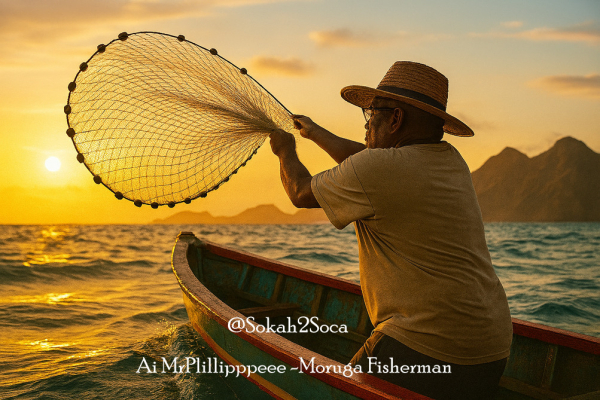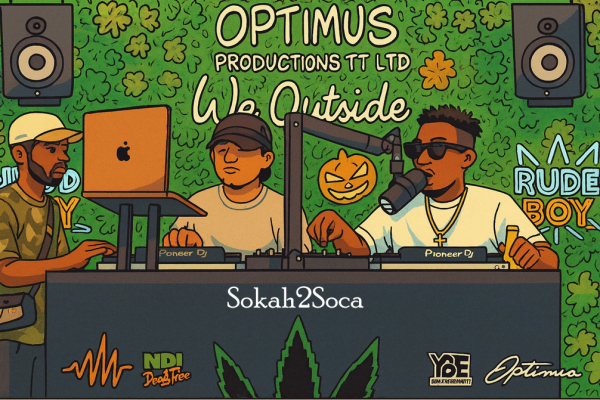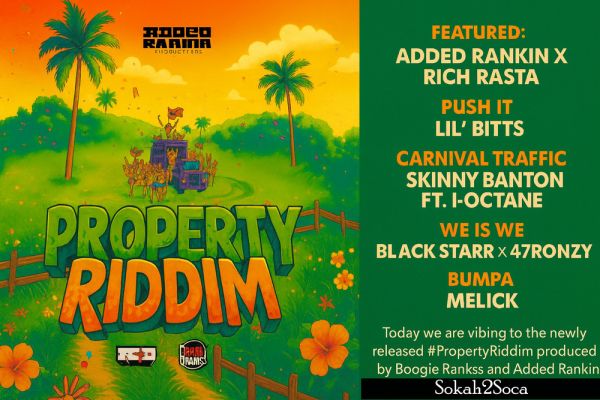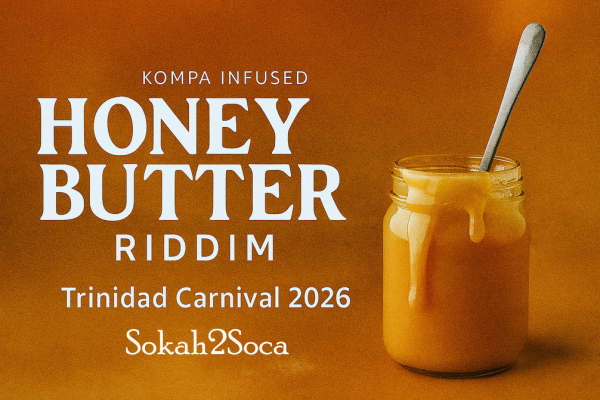World Premiere Alert: AI-Generated Soca Track Stuns WACK Radio Listeners
By Ananda/Sokah2Soca
in
Blog
November 03, 2025
Dive deeper into Caribbean music and culture at Sokah2Soca — your go-to source for Soca, Calypso, and Carnival coverage. First published on Sokah2Soca, now streaming live via Island Vybe Radio.
Challenge accepted—and executed in record time! Today is the World Premiere of "Moruga Fisherman" by AiMrPhillipppeee, a Latin-flavored Soca track done in minutes.
Sunday will go down in the annals of Dotish History as the day AI Soca music crawled out of a computer and splashed onto the airwaves of WACK Radio 90.1 FM. It all started during De Dotish Hour, when Mr. Desmond threw down the gauntlet (or was it a wet fish?): could Kenny Phillips use AI to create a song live on air?
Enter AiMrPhillipppeee—armed with prompt engineering and zero fear. The mission? A track about a Moruga fisherman who loves casting his net off the coast of Venezuela. The result? Moruga Fisherman—a Latin-flavored Soca jam whipped up in minutes and served hot on the airwaves.
Deso was stunned. Callers were buzzing. And somewhere in Moruga, a fisherman probably started humming his new theme song.
So we ask you: is AI the end of music producers as we know them… or the creative adrenaline shot that will catapult music production. What is your opinion?
Let us spread awareness of the culture of the Caribbean diaspora.
We do this to promote Caribbean culture, musicians, and music producers. We are able to honor and promote the rich sounds and stories of the Caribbean thanks to your support. Together, we can ensure that this rich cultural legacy reaches a wider audience and fosters creativity and connections. While it is important to always purchase music, you should avoid sharing promotional music because doing so denies essential revenue to songwriters, producers, and artists. You can find all of our posts online on social media platforms like Facebook, YouTube, Instagram, Spotify, and SoundCloud. We recommend that you explore your favorite content on FeedSpot/RSS Feed, Threads, Bluesky, and Twitter/X, including email subscriptions. Thank you in advance.
Production Notes/Music Credits:
Song Title: Moruga Fisherman
Artist/Performed by: AiMrPhillipppeee
Written by: AiMrPhillippe
Produced by: Ai Music Generator
Copyright: AiMrPhillipppeee @WACKVisualRadio90.1FM
Origin: Trinidad, Republic of Trinidad & Tobago
Genre: Latin Soca ?
?Listen. Share. Amplify. Our artists embody culture not only during Carnival but also on a daily basis. Sokah2Soca—Where Rhythm Lives and Calypso, Steelband Music, and Soca Thrive!
We present the music here for your listening pleasure and promotional purposes only, adhering to the "Fair Use" Musical Content Copyright Disclaimer under Section 107 of the Copyright Act 1976. Sokah2Soca/Soca Music Blog © 1990 by Santiwah is licensed under CC BY-SA 4.0. To view a copy of this license, visit https://creativecommons.org/licenses/by-sa/4.0/.
♫Please click the small triangle button in the music player below to listen now.
We Outside 76: Chutney Meets Reggaeton and It’s Pure Vibes
By Ananda/Sokah2Soca
in
Blog
November 01, 2025
This post first appeared on Sokah2Soca, where Caribbean music meets wit, rhythm, and real talk. Island Vybe Radio spins the tunes—we decode the culture.
Yung Bredda's popularity is rapidly growing, particularly in the Caribbean and North America, and his performance on We Outside 76 demonstrates his charisma and rhythmic ability to effortlessly navigate any riddim. Backed by DJ Hotty and SoundBoy Ryan on the 1’s and 2’s, this mix is a celebration of Caribbean-Latin fusion—Chutney meets Reggaeton, and the result is pure vibes.
?? For the Venezuelans in Trinidad, this one hits home, yes, there is a sprinkle of latin vibes in the presentation. The Latin tracks woven into the mix offer a familiar pulse, while the Chutney elements keep it grounded in Trini flavor. It’s a sonic bridge between cultures, and Sokah2Soca is proud to be part of that movement—bringing the best music to the world.
Whether you’re liming in Brooklyn or Queens, or just cruising through Curepe, or just vibing in your headphones, We Outside 76 is your soundtrack for joy, movement, and connection. Vibes all the way; the joy shown by Yung Bredda and his team just adds to the enjoyment.
Let us spread awareness of the culture of the Caribbean diaspora.
We do this to promote Caribbean culture, musicians, and music producers. We are able to honor and promote the rich sounds and stories of the Caribbean thanks to your support. Together, we can ensure that this rich cultural legacy reaches a wider audience and fosters creativity and connections. While it is important to always purchase music, you should avoid sharing promotional music because doing so denies essential revenue to songwriters, producers, and artists. You can find all of our posts online on social media platforms like Facebook, YouTube, Instagram, Spotify, and SoundCloud. We recommend that you explore your favorite content on FeedSpot/RSS Feed, Threads, Bluesky, and Twitter/X, including email subscriptions. Thank you in advance.
Production Notes/Music Credits:
Song Title: We Outside 76 Chutney Meets Reggaeton
Featuring: Yung Bredda, DJ Hotty and DJ SoundBoy
Origin: Trinidad, Republic of Trinidad & Tobago
Genre: Chtuney/Chutney Soca/Reggaeton ?
?Listen. Share. Amplify. Our artists embody culture not only during Carnival but also on a daily basis. Sokah2Soca—Where Rhythm Lives and Calypso, Steelband Music, and Soca Thrive!
We present the music here for your listening pleasure and promotional purposes only, adhering to the "Fair Use" Musical Content Copyright Disclaimer under Section 107 of the Copyright Act 1976. Sokah2Soca/Soca Music Blog © 1990 by Santiwah is licensed under CC BY-SA 4.0. To view a copy of this license, visit https://creativecommons.org/licenses/by-sa/4.0/.
♫Please click the small triangle button in the music player below to listen now.
Dive deeper into Caribbean music and culture at Sokah2Soca — your go-to source for Soca, Calypso, and Carnival coverage. First published on Sokah2Soca, now streaming live via Island Vybe Radio.
Listening to well-produced music is a wonderful way to start the weekend; we have a new album release and you are going to love it. Every song on this album has a vibe and should become a DJ favorite for Carnival 2026. We are showcasing the music from the recently released "Property Riddim," a track that radiates pure vibes from start to finish.
Featured tracks:
- Property—Added Rankin x Rich Rasta
- Push It —Little' Bitts
- Carnival Traffic – Skinny Banton ft. I-Octane
- We Is We—Black Starr x 47Ronzy
- Bumpa—Melick
Produced by the dynamic duo Boogie Rankss & Added Rankin, this riddim is a sonic passport to Carnival energy, lyrical cleverness, and rhythmic finesse. Jemel Billinghurst composed the magical melody that propels this rhythm.
Every tune, from Property's bold declarations to Bumpa's bumper-shaking pulse, brings its own unique flavor to the riddim. This album delivers music that will 'tun-up' carnival fetes from Christmas to Carnival... we are confident that this album is going to become a carnival banger!
Press play. Feel the flow. Share the vibe.
Let us spread awareness of the culture of the Caribbean diaspora.
We do this to promote Caribbean culture, musicians, and music producers. We are able to honor and promote the rich sounds and stories of the Caribbean thanks to your support. Together, we can ensure that this rich cultural legacy reaches a wider audience and fosters creativity and connections. While it is important to always purchase music, you should avoid sharing promotional music because doing so denies essential revenue to songwriters, producers, and artists. You can find all of our posts online on social media platforms like Facebook, YouTube, Instagram, Spotify, and SoundCloud. We recommend that you explore your favorite content on FeedSpot/RSS Feed, Threads, Bluesky, and Twitter/X, including email subscriptions. Thank you in advance.
Production Notes/Music Credits:
Song Title: Property
Artists/Performed by: Added Rankin x Rich Rasta
Written by: M'Fede Ruben and Jemel Billinghurst
Composer: Jemel Billinghurst
Song Title: Push it
Artist: Lil Bitts
Written by: Seumas Keelan Callender
Mixed & Mastered by: Parry Jack
Song Title: Carnival Traffic
Artist/Performed by: Skinny Banton ft. I-Octane
Written by: Shirley Christian George
Composed by: Jemel Billinghurst
Song Title: We Is We
Artist/Performed by: Black Starr x 47Ronzy
Written by: Arnold Noel
Composed by: Jemel Billinghurst
Song Title: Bumpa
Artist/Performed by: Melick
Written by: Melick Baptiste and Nigel English
Composed by: Jemel Billinghurst
Album Title: Property Riddim
All Songs Produced by: Boogie Rankss & Added Rankin
Genre: Soca ?
?Listen. Share. Amplify. Our artists embody culture not only during Carnival but also on a daily basis. Sokah2Soca—Where Rhythm Lives and Calypso, Steelband Music, and Soca Thrive!
We present the music here for your listening pleasure and for promotional purposes only, in accordance with the "Fair Use" Musical Content Copyright Disclaimer under Section 107 of the Copyright Act 1976. Sokah2Soca/Soca Music Blog © 1990 by Santiwah is licensed under CC BY-SA 4.0. To view a copy of this license, visit https://creativecommons.org/licenses/by-sa/4.0/.
♫Please click the small triangle button in the music player below to listen now.
Honey Butter Riddim Is Serving Kompa Heat for Carnival 2026: Butter Up Your Playlist
By Ananda/Sokah2Soca
in
Blog
October 28, 2025
Dive deeper into Caribbean music and culture at Sokah2Soca — your go-to source for Soca, Calypso, and Carnival coverage. First published on Sokah2Soca, now streaming live via Island Vybe Radio.
As Carnival season intensifies, the Soca scene is exploding with new releases. We noticed that some of the newly released songs, including this album, have embraced sweet and sexy Kompa (Konpa) rhythms. We love the fusion. However, because of the constant and abundant music releases, we decided to do this post to feature all four songs on the album. Let's put it this way: we simply needed one buttery spotlight.
To be honest, I am not confident that Trinidad DJs and the general public will embrace this Kompa-infused rhythm for a Soca-based Carnival culture. I am keeping hope alive for his album as it relates to my Trini posse. This Honey Butter Riddim is not just another entry in the Carnival catalog—it’s a curated vibe. Produced, mixed, and mastered by N.M.G Music for Trinidad & Tobago’s 2026 Carnival. All guitar and bass licks are by Kyle Peters, lending to this Kompa-kissed riddim. The vibe is smooth, sweet, and unapologetically Caribbean. So instead of slicing it up, Sokah2Soca is serving the whole spread right here.
This album is not just a riddim—it’s a mood. A groove. This song serves as a tribute to the gentler side of Carnival. Let’s break it down:
- "OnlyFans"—Yung Bredda is surprising the Soca industry with his controlled sensual vocals on the Honey Butter Riddim. He is bringing joy to fans of the French-Creole musical style, effortlessly blending with the Kompa-infused production. After all, Kompa is Haiti’s sensual side gifted to the world, and Bredda knows how to honor that legacy. Lyrically, he’s all heart: “more than a lover,” “I am your only man”—this is intimacy with intention. The video adds visual heat by featuring dancers and a striking model who amplify the song’s romantic and energetic pulse. With over 46,000 views on YouTube in just 10 days, “Only Fans” is already making waves.
- “Butter”—Nadia Batson She’s not just singing—she’s sizzling. Nadia channels heat, desire, and that melt-in-your-mouth kind of passion. It is Kompa with a Soca soul, and it will have you slipping into something sweet.
- “Smooth Criminal”—Freetown Collective. There is no need to steal hearts when they are freely given. TThis song is for the lovers who know that vulnerability is strength. Freetown delivers tenderness with swagger, and we’re here for it.
- “Dancin”—Adam O. Weekend warriors, this is your anthem. Adam O invites you to leave the stress behind and step into joy. It has island vibes that are pure and simple—just press play and move.
- “No Complaints”—Preedy” Written by Josiah Noray, this mellow magnet pulls you close and keeps you there. It captures the essence of Carnival intimacy through slow wine, soft smiles, and a day that feels endless. No stress. No fuss. No complaints.
The Honey Butter Album/Riddim demonstrates that Carnival is not only about pace but also emphasizes the importance of rhythm. It's about emotions. It's about vibe. Sokah2Soca celebrates this buttery brilliance, along with the artists who brought it to life.
Let us spread awareness of the culture of the Caribbean diaspora.
We do this to promote Caribbean culture, musicians, and music producers. We are able to honor and promote the rich sounds and stories of the Caribbean thanks to your support. Together, we can ensure that this rich cultural legacy reaches a wider audience and fosters creativity and connections. While it is important to always purchase music, you should avoid sharing promotional music because doing so denies essential revenue to songwriters, producers, and artists. You can find all of our posts online on social media platforms like Facebook, YouTube, Instagram, Spotify, and SoundCloud. We recommend that you explore your favorite content on FeedSpot/RSS Feed, Threads, Bluesky, and Twitter/X, including email subscriptions. Thank you in advance.
Production Notes/Music Credits:
Song Title: Only Fans
Artist/Performed by: Yung Bredda
Written by: Jonesy
Song Title: Butter
Artist/Performed by: Nadia Batson
Honey Butter Riddim
Lyricists/Written by: Nadia Batson/Erikkson George
Composed by: Nikholai Greene
Song Title: Smooth Criminal
Artist/Performed by: Freetown Collective
Written by: Freetown Collective and Kit Israel
Song Title: Dancin
Performed by: Adam O
Written by Adam O
Preedy—No Complaints
Written by Josiah Noray
Background Vocals by Sariah Noray
All Songs:
Album Name: Honey Butter Riddim
Guitars and Bass by: Kyle Peters
Produced, Mixed and Mastered by: N.M.G Music
Released on: 2025-10-25
Origin: Trinidad, Republic of Trinidad & Tobago
Genre: Soca/Kompa Fusion ?
? Listen. Share. Amplify. Our artists embody culture not only during Carnival but also on a daily basis. Sokah2Soca—Where Rhythm Lives and Calypso, Steelband Music, and Soca Thrive!
We present the music here for your listening pleasure and promotional purposes only, adhering to the "Fair Use" Musical Content Copyright Disclaimer under Section 107 of the Copyright Act 1976. Sokah2Soca/Soca Music Blog © 1990 by Santiwah is licensed under CC BY-SA 4.0. To view a copy of this license, visit https://creativecommons.org/licenses/by-sa/4.0/.
♫ Please click the small triangle button in the music player below to listen now.





